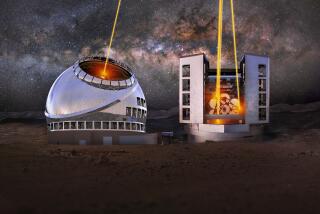Scientists Hope to Hear Sounds of Life in Space
GOLDSTONE DRY LAKE, Calif. â In the barren landscape of the Mojave, scientists are preparing to bend a computerized ear to the heavens to listen for sounds of alien worlds.
The project, which would be the most sophisticated of its kind in the nation if approved by Congress this year, would link radio antennae across the globe and a multimillion-dollar computer to systematically sort through radio signals from the 100 billion to 200 billion stars in the galaxy.
Because there is no scientific proof that intelligent life exists elsewhere in this galaxy or in any other, the proposed search for extraterrestrial intelligence would be an unusual project for the normally pragmatic National Aeronautics and Space Administration.
âIt is kind of a mix of science fiction and scientific fact,â said Michael J. Klein, deputy director of the program at the Jet Propulsion Laboratoryâs Goldstone Deep Space Tracking Station about 120 miles northeast of Los Angeles in the desert.
âBut (the program) is an experiment that is serious,â he said. âI think it has broad popular support. The public is interested in it. It is addressing the great philosophical questions of human destiny.
âThere Is a Purposeâ
âIf you donât think philosophically, if you only care where your next beer is coming from, then you wonât care,â said Klein, a radio astronomer at JPL near Pasadena.
âBut I believe there is a purpose in all this. We as a civilization are part of something bigger, and this is to help us gain a perspective of who we are in the grander scheme of things.â
Armed with the discovery in other solar systems of elements that are building blocks of life, scientists have good reason to believe that life could exist on yet-to-be discovered planets, Klein said.
âThe conditions for life seem to be there,â he said. âThe chances of life being out there are good.â
Klein is confident that Congress will approve the project, which represents only a fraction of NASAâs total budget and seems small contrasted with the $2 billion-plus it would take to build a new space shuttle orbiter.
NASA has already paid $8 million to scientists at the JPL Ames Research Center at Moffett Field in Mountain View, Calif., for research and planning during the last four years.
Congress to Decide
The actual project, which would cost $80 million for a 10-year operating period, will go before Congress this year for approval of the concept and $5.5 million for the first year of operation, scheduled for 1988.
If approved, the project would be fully operational by 1992.
Scientists would use the 85-foot deep-space listening antenna already erected at the Goldstone tracking station, situated in a dry lake bed about 35 miles north of Barstow in the Mojave Desert.
In addition, antennae at the NASA-JPL tracking stations in Australia and Spain would be used, as well as the globeâs tallest listening antenna, the 1,000-foot diameter antenna at the agenciesâ tracking center in Arecibo, Puerto Rico. The antennae are normally used by the two agencies to track and communicate with NASAâs satellites.
The antennae would pick up millions of microwave radio signals from outer space, feeding them to the Goldstone computers, which would break the invisible waves into 100 million channels for inspection.
Although scientists have erected tracking stations for the last 25 years throughout the globe to search for intelligent life beyond Earth, the facility at Goldstone would be the largest and the most sophisticated, using the computer to replace workers to sort out unwanted radio waves.
Unwanted waves include those from airplanes, man-made satellites and natural waves emanating from other planets, stars, pulsars, quasars and other galaxies, Klein said.
âVery Shrill Fluteâ
Scientists are not exactly sure how they would recognize an artificial radio wave, but they believe it would stand out from the patternless cacophony of natureâs airwaves.
âItâs sort of listening to an orchestra and all of a sudden youâve got a very shrill flute note that stands out against the rest,â Klein said.
There is always the possibility that the search, which would reach back 1,000 light years and therefore could reach back in time, would pick up a signal from a civilization that has undergone drastic transformations or no longer exists, Klein said.
âIn that case, it will be communication between cultures instead of between individuals,â he said.
There is also the problem of deciphering the radio signals from another civilization. âAstro-cryptologistsâ would be needed, but having no previous experience, they would have to learn on the job by trial and error.
No decision has been made on whether to reply or on what would be said if another civilization were found, Klein said. For one thing, some are worried about discovering a hostile alien world.
âSome people claim you shouldnât whistle in the jungle,â he said. âBut I think the chances are remote that anything will be close enough to be a threat.â






